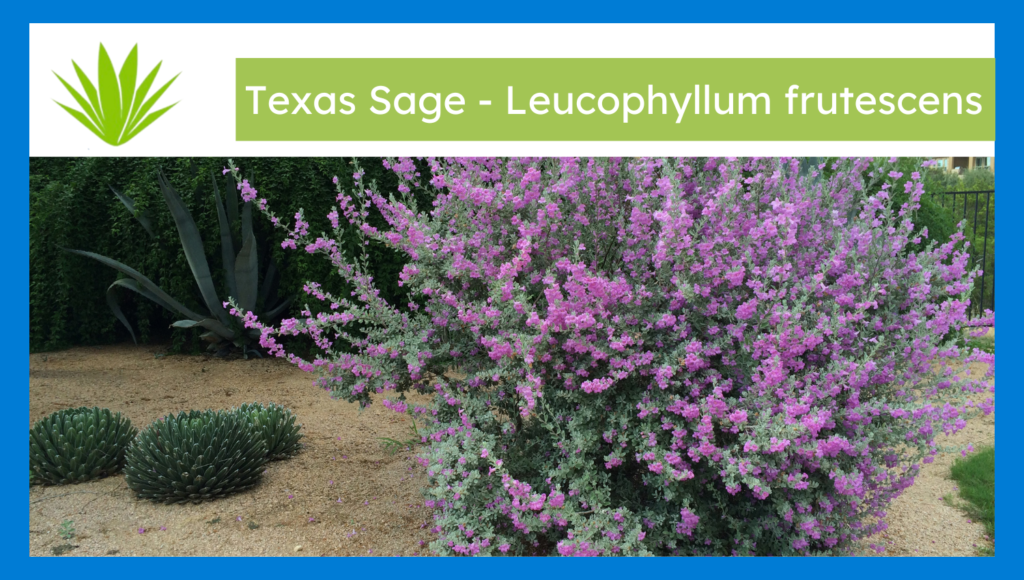The Texas Sage (Leucophyllum frutescens) grows in the southwestern United States regions and northern Mexico territory. A typical Texas Sage plant measures between 4 to 8 feet in height with a matching width of 4 to 6 feet or greater. After watering events Texas Sage produces purple, pink, or lavender flowers which grow against its silvery-gray leaf structure. The yearly growth spans from 20 to 40 centimeters in measurement. Texas Sage grows best in soils that are both rocky and poor while demanding only 25 cm or less of annual rainfall. Flowers of Agave get their cross-fertilization from bees and butterflies. Its dense structure serves as protection for wildlife creatures. This plant displays high resistance to drought and heat alongside deer resistance and needs very little gardening care. The drought-tolerant Texas Sage serves as a popular selection in xeriscaping because it adds beautiful color to resistant landscapes.
| Characteristic | Description |
| Size | Typically 3 to 5 feet tall, with a rounded or bushy shape. |
| Appearance | Grayish-green, silvery foliage with small, oblong leaves. |
| Spines | No spines; the plant is bushy with soft leaves. |
| Flowers | Funnel-shaped flowers, usually purple, pink, or white, that bloom in clusters. |
| Fruits | Small, rounded capsules containing seeds, typically not noticeable. |
| Root System | Deep, drought-tolerant roots, helping it thrive in arid conditions. |
| Lifespan | Can live 10-15 years or more. |
| Habitat | Native to arid regions, especially in Texas and Northern Mexico, in well-drained soils. |
| Water Storage | Stores water in the roots and leaves, making it highly drought-tolerant. |
| Growth Rate | Moderate to fast growth, up to 2 feet per year in favorable conditions. |
| Flowering Time | Late spring to early fall, typically after rain. |
| Reproduction | Seeds dispersed by wind; can also propagate by cuttings. |
Table of Contents
How to Propagate, Grow, and Plant Texas Sage?
Texas Sage (Leucophyllum frutescens) grows successfully through cuttings taken from semi-hardwood sections. Cuttings of 10 – 15 cm root well in sandy, well-drained soil. Texas Sage achieves 80% successful germination when using a rooting hormone. Texas Sage displays annual growth between 20 to 40 centimeters. The plant requires complete sun exposure with minimum daily requirements of six uninterrupted hours of sunlight. Soil pH between 6.6 – 8.5 supports healthy development. Proper ventilation occurs when plants are spaced at 1.2 to 1.8 meters (4 to 6 feet). During dry months the plant requires minimal watering equivalent to 2.5 cm weekly. Texas Sage shows strong tolerance for temperatures ranging between -12°C and 45°C. Pruning after flowering enhances shape. The plant demonstrates exceptional drought tolerance of over 90% making it a desirable choice for xeriscaping landscapes in hot desert areas.
When and how to Prune and Trim Texas Sage?
The Texas Sage plant needs pruning during late summer or early fall after its flowering period. Cut 20 to 30 percent of the plant growth to sustain its form. It is important to use clean and sharp tools when protecting plants from harm. Better air circulation results from removing dead or damaged branches. Avoid making deep cuts on Texas Sage plants because this action diminishes flower production.
How Big and Fast does Texas Sage get?
The Texas Sage species (Leucophyllum frutescens) has a height range between 120 and 240 cm while spreading to 120 – 180 cm throughout its growth. The growth rate of Texas Sage progresses at a level of 20 – 40 cm during each year. Its drought tolerance exceeds 90%. Its foundation system penetrates down to 50 – 80 cm below the surface for steadiness. The flowers intensify their production to 70% with proper drainage of the soil. It withstands temperatures from -12°C to 45°C.
Is Texas Sage Poisonous to Humans and Dogs?
Texas Sage (Salvia coccinea) presents no harm to humans or dogs. According to the ASPCA (American Society for the Prevention of Cruelty to Animals), the substance remains safe when used by dogs. When dogs consume large quantities of this plant it could produce mild gastrointestinal discomfort resulting in vomiting together with diarrhea. The skin of certain people develops mild irritation when they stay in direct contact with the plant for too long. Mothers should observe the interactions between people and Sage plants to ensure safety.
When does Texas Sage Bloom?
Texas Sage Leucophyllum frutescens blooms during early summer until the initial autumn frost arrives. Texas Sage produces flowers constantly in areas that experience temperate climates. When humidity levels rise or rainfall occurs the process of flowering becomes initiated. Texas Sage produces repeated blooming during summer and fall seasons that are most common following rainfall.
Is Texas Sage Evergreen?
Texas Sage (Leucophyllum frutescens) exists as an evergreen shrub throughout the year. It maintains its foliage year-round. Some leaves may naturally drop from Texas Sage during the winter season. The plant grows to reach a height of 6 feet in stature. The bush displays dense silvery-green leaves that have a covering of velvety hairs. The plant prefers scorching hot environments with dry conditions. It is drought-tolerant and low-maintenance. Central Texas along with southern Texas provides the natural habitat for Texas Sage plants.
About The Author
Isaiah Espinoza
Isaiah Espinoza is the proud company owner, founder and driving force behind Legacy Landscaping and Design. Isaiah established Legacy Landscaping & Design in 2014, bringing his vision of creating stunning outdoor spaces to life. Isaiah, the founder of Legacy Landscaping & Design, has a deep-rooted passion for construction and design, stemming from four generations of family expertise in the industry. With a KB-1 General Building License and a CR-21 Hardscaping and Irrigation License, Isaiah has spent the past decade transforming outdoor spaces with exceptional craftsmanship and innovative design.

